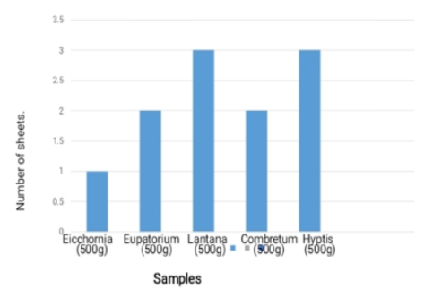


Indian Journal of Science and Technology
DOI: 10.17485/IJST/v17i20.1350
Year: 2024, Volume: 17, Issue: 20, Pages: 2110-2116
Original Article
K Sreeranjini1*
1Post Graduate, Department of Botany, Little Flower College, Guruvayur, Thrissur District, Kerala, India
*Corresponding Author
Email: [email protected]
Received Date:22 April 2024, Accepted Date:05 May 2024, Published Date:18 May 2024
Objectives: The study focuses on utilising invasive flora affecting the indigenous plants and thereby bring about monetary benefits to the local people by means of handmade papers from the invasive weeds. Methods: Handmade paper from five invasive plants namely, Eichhornia crassipes, Eupatorium odorata, Combretum indicum, Lantana camara and Hyptis capitata was attempted. These plants after collection from Nilambur, Kerala were subjected to treatment with washing soda, blending, vat preparation, moulding and drying. This is followed by checking the paper quality parameters viz., Productivity, Clarity/opacity/transparency, Strength, Grammage, Paper grain, Ageing of paper and Moisture content. Findings: Out of the five invasive plants tested, the fibre yield was maximum for Eichhornia, but the productivity rate was less compared to other samples. Lantana and Hyptis yielded maximum productivity even though the fibre yield from these plants was less. The fibre uniformity of paper developed was positively detected for all the 4 plants except Eichhornia thereby proving the feasibility for paper manufacture. All sample paper allows the light; so, all are translucent in nature. Integrity of paper samples was retained in the paint test. The age test also yielded positive results. The gsm test showed lowest for Eichhornia as 98.12g/m2; Lantana 111.87g/m2; Combretum 131.87g/m2; Hyptis 163.75g/m2; Eupatorium is 255g/m2. Even though the gsm of Eichhornia is the best for paper manufacture according to gsm standards, the lack of fibre uniformity is a withdrawing feature for feasibility. The moisture content appeared high for Eichhornia and lowest for Combretum. Novelty: To date, studies on invasive plant utilisation done individually; no comparative study on productivity done. Current study can be further refined for environmental sustenance along with livelihood for local people.
Keywords: Invasive Flora, Paper manufacture, Grammage test, Productivity, Ecological sustainability
© 2024 Sreeranjini. This is an open-access article distributed under the terms of the Creative Commons Attribution License, which permits unrestricted use, distribution, and reproduction in any medium, provided the original author and source are credited. Published By Indian Society for Education and Environment (iSee)
Subscribe now for latest articles and news.